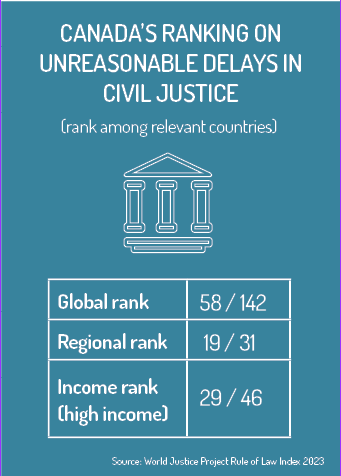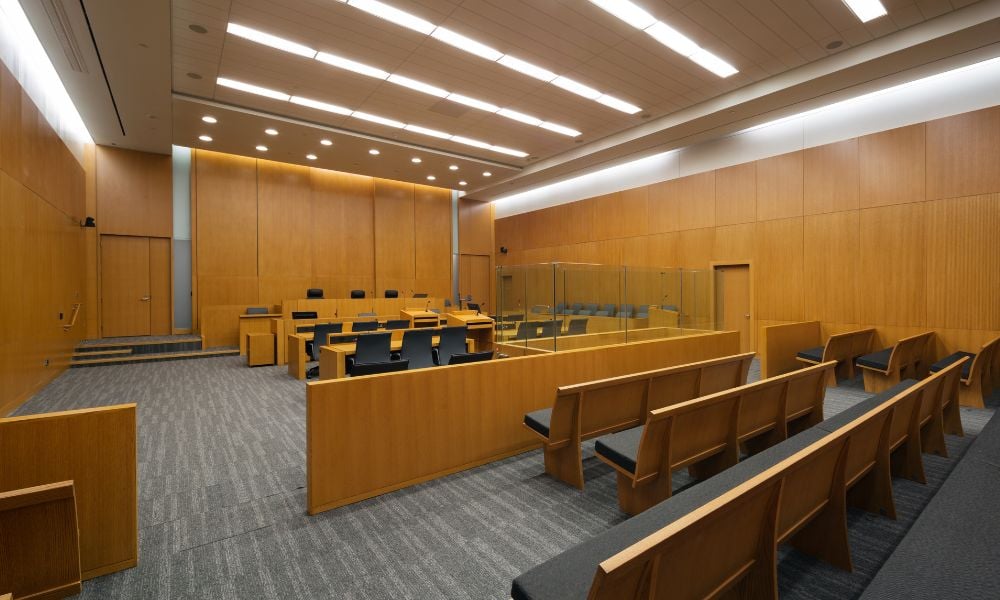The adage “justice delayed is justice denied” is being played out in Canadian courtrooms across the country and is becoming a severe problem in civil litigation, lawyers say.
“Current delays in even getting motions and cases heard – sometimes months or years – are causing people to turn away from the civil court system as a way of resolving disputes,” says Ian Matthews, a commercial litigation lawyer with Borden Ladner Gervais LLP in Toronto.
It’s not just Canadian litigators noticing the impact of delays. The World Justice Project published a 2023 report on the rule of law in 142 countries, determined through in-country household and expert surveys.
Recent rule of law indexes are based on eight factors, using 43 separate measures, on a scale ranging from 0.0 to 1.0, lowest to highest. The lowest of all 43 measures for Canada in 2023 was a score of 0.46 for “no unreasonable delays” in its civil justice system. This is similar to scores in previous years, and Matthews says he sees evidence of this daily.
“Anyone involved in the system regularly would tell you that the current system is very close to collapsing under its own weight.”
The nature of family law cases – especially the impact on children and potential for domestic violence – and the constitutional issues related to criminal cases necessitating them being heard in a timely manner – mean that civil matters are generally third in line when prioritizing court proceedings. This may be for legitimate reasons, Matthews says, “as there is an urgency that trumps civil cases, but it’s not right to say that civil cases aren’t important.”
He points to small businesses that can’t survive because they are owed money tied up in a legal dispute. The worst-case scenario is businesses shutting down because they can’t recover what’s owed to them promptly.
The other tangible impact is that if it takes four or five years to reach an endpoint, people may settle their claims for far less than they are entitled to. “You might be owed $100,000, but you’ll take 40 or 50 percent to settle, and that’s to the advantage of those refusing to pay.”
Matthews adds that the delays in the civil litigation system could even have an impact on a jurisdiction’s image as a good place to do business. “Many people would say, ‘I found myself having to go to court again; I better make sure it’s not in Ontario or wherever because I know there won’t be a way to remedy my dispute in a timely way.’ Or, if they are fortunate enough to have money to resolve the dispute, they’ll take the path of private arbitration.”
Gillian Dingle, practice group leader with the litigation department at Torys LLP and co-head of its securities defence practice, says that “at the macro level, delays in the civil litigation space are problematic for everyone – for litigants, for counsel, and the court system in general.
“Memories fade over time, so the further away you get from an incident, the more difficult it is for people to remember what happened, and the costs of litigation increase as it gets pushed further into the future.”
She says that as a practitioner in Toronto, which has the advantage of having a Commercial List of judges and support staff with experience managing complex commercial litigation, it can still take months or years to schedule a motion or trial. For example, Dingle says, it can take eight months from the day requested to get a short motion, a hearing under two hours, and at least a year for a longer motion or trial.
“When thinking about bringing on a motion, I’m anticipating it is going to be at least six months before it can be heard.”
As a consequence of the 2026 Supreme Court of Canada decision in R. v. Jordan, saying most trials should finish either 18 or 30 months after a person is charged, depending on the type of trial, and that anything longer is “unreasonable,” civil cases are often pushed off to prioritize criminal cases. “We understand at a big picture level that civil cases don’t deal with the loss of someone’s liberty, that the system prioritizes criminal cases, which is the right move, but it does have consequences for the civil system.”
Dingle says another reason for the delays is a “chronic understaffing” of judges, with many unfilled vacancies. This means that those judges available to hear cases are overburdened. She notes she had one case outside of Toronto in which the application hearing kept getting adjourned because there was no judge. That case lasted for about three years.
“To have a case admittedly heard and told there is no judge is very difficult and costly.” Dingle says some recent judicial appointments will help alleviate some of these delays, but right now, “judges are being asked to do a huge amount of work with few resources.”
Another reason for delays, Dingle says, is that “litigators have become comfortable with a certain level of procedural protection for our clients – the ability to bring a motion on issue X, Y, or Z – but that means the trial date may be delayed to accommodate whatever procedural argument you’re fighting about.
“Lawyers are naturally resistant to give up something they think might be useful to their client.”
Moya Graham, a partner with McCarthy Tétrault LLP, says courts “are working very hard” in challenging circumstances and are not responsible for the development of a backlog. However, the availability of judges and court staff, relative to demand, appears to be the biggest problem and the hardest to solve.
“In a climate where it takes a long time to get before the court, what would previously have been a shorter delay has a bigger impact. It is not uncommon to have a scheduled motion or trial be cancelled because the resources are not there to hear the matter in the planned time frame, or other cases need to take priority. The civil justice system has become overloaded.”
Jesse Harper, a partner in the litigation practice at Fasken Martineau DuMoulin LLP, agrees that there is often a “culture or approach” to litigation in which there is an incentive to use procedural wrangling to serve a particular party’s interests – creating delays as a tactical tool.
Harper says that while litigators should always be “zealous advocates” for their clients’ interests, “what is more questionable is the procedural wrangling – delay for the sake of delay to grind down the other side.” He adds: “I think lawyers have a duty to the court to maybe take a second look about whether [such delays] are in everybody’s interests and in accordance with their professional obligations.”
He notes that the Ontario government recently announced a plan to overhaul the Rules of Civil Procedure, putting together a working group for that purpose. The group is tasked with identifying issues and developing proposals for reforming the rules to make the civil court process more efficient and affordable. Specifically, it is looking at reducing costs, maximizing the use of court resources, and leveraging technology to improve access to justice.
“I think there is recognition that the current rules of procedure are at least partially responsible for the system’s inefficiency,” Harper says, noting they were “drafted in a very different time.”
Changes to procedures could address “modernizing the court so we have working virtual technology that can do virtual hearings and can schedule things online rather than having to walk up to the court – and those little things that you don’t necessarily think of causing a huge delay can add up.”
Harper says the Commercial List in the Toronto area does solve some of the issues related to delays “and provides one path to quicker justice.” However, it is not a panacea and wouldn’t necessarily work in other jurisdictions. For most of Canada, “there is a real issue where people are looking at the civil system and saying, ‘Is it worth my time? Is it worth my money to spend five years fighting this?’ It has to be a pretty significant issue to warrant it.”
Harper also points out that while there is a focus on the understaffing of judges, there are concerns about the overall staffing of the judicial system. “There have been reports about difficulties with getting court staff and court staff leaving,” he says. (Unions representing court workers have said it relates to wages, which, they say, make it difficult to commute and park in downtown courthouses especially.)
“When you lose a lot of personnel and institutional knowledge this way, that can have a real drain on the efficiency of the system.”
Matthews at BLG says dealing with the delays in the civil court system, even if the number of judges and staffing were to increase, would involve a “fundamental rethinking and rewriting of the Rules of Civil Procedure” to recalibrate the balance between the need for intricate legal arguments and “timely access to justice.”
Effective case management of civil litigation is also essential to reduce delays. “Judges and lawyers need to be reconditioned about what’s expected in a court case – it shouldn’t be assumed that it takes four or five years for resolution.”
Graham at McCarthy Tétrault says there is “good reason” to be optimistic that the significant changes anticipated from the procedural rules reform will be successful.
“We need to be more efficient with the resources that are available. My own view is that different types of cases require different things to increase efficiency. More differentiation in procedures across types of cases, similar to the Commercial List, would help.”
As for whether justice delayed in our civil court system has reached the point of being justice denied, Matthews says if we haven’t “already hit that tipping point,” we’re very close.
“If we’re a country that believes in the rule of law, we have to have a court system that works,” he says, “and the system has to work for everyone.”






